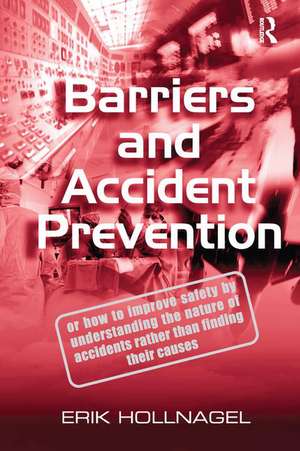Barriers and Accident Prevention
Autor Erik Hollnagelen Limba Engleză Paperback – 9 sep 2016
| Toate formatele și edițiile | Preț | Express |
|---|---|---|
| Paperback (1) | 481.65 lei 6-8 săpt. | |
| CRC Press – 9 sep 2016 | 481.65 lei 6-8 săpt. | |
| Hardback (1) | 787.91 lei 6-8 săpt. | |
| CRC Press – 22 oct 2004 | 787.91 lei 6-8 săpt. |
Preț: 481.65 lei
Nou
Puncte Express: 722
Preț estimativ în valută:
92.16€ • 96.42$ • 76.56£
92.16€ • 96.42$ • 76.56£
Carte tipărită la comandă
Livrare economică 03-17 aprilie
Preluare comenzi: 021 569.72.76
Specificații
ISBN-13: 9781138247352
ISBN-10: 1138247359
Pagini: 242
Dimensiuni: 156 x 234 x 16 mm
Greutate: 0.43 kg
Ediția:1
Editura: CRC Press
Colecția Routledge
ISBN-10: 1138247359
Pagini: 242
Dimensiuni: 156 x 234 x 16 mm
Greutate: 0.43 kg
Ediția:1
Editura: CRC Press
Colecția Routledge
Cuprins
Contents: Accidents and causes; Thinking about accidents; Barrier functions and barrier systems; Understanding the role of barriers in accidents; A systemic accident model; Accident prevention; Bibliography; Author index; Subject Index.
Notă biografică
Erik Hollnagel has been Full Professor of Human-Machine Interaction at Linköping University (S), since 1999. Previously Principal Advisor, OECD Halden Reactor Project, Norway (1995-1999); Technical Director, HRA Ltd., UK (1993-1995); Senior researcher, Department Manager, and later Principal Scientist, Computer Resources International, Denmark (1985-1993). In addition to Coping with Computers in the Cockpit edited with Sidney Dekker, he has written two books on reliability and accidents: Human reliability analysis, Academic Press, 1993; Cognitive Reliability and Error Analysis Method, 1998 and Cognitive Task Design, 2003. He has worked closely with the patient safety programmes in Sweden, training doctors and nurses in risk assessment.
Recenzii
’Every twenty years or so, a book comes along that profoundly influences the way we think about the breakdown of complex systems. Charles Perrow's Normal Accidents (1984) was one; this book will be another. Beautifully written, immensely scholarly and rich in illustrations, it both challenges the received wisdom about accident aetiology and (unlike Perrow) offers a viable way forward. This book establishes Erik Hollnagel as the leading thinker in this field.’ Professor James Reason, University of Manchester, UK 'This important, thought-provoking book should be required reading for accident prevention professionals and anyone concerned with enhancing system safety. The discussion of barriers, and the strengths and weaknesses of three types of accident models - accented by easy to understand diagrams and tables - provides background for the insightful description of the complexities of the increasingly significant systemic model and its proactive implications for designing systems for accident prevention.' Marilyn Sue Bogner, Ph.D., Institute for the Study of Human Error, Bethesda, USA '... the contents are up to the expected high standard of this prolific publishing house.' The ROSPA Occupational Safety & Health Journal 'This work is aimed at those at the top of the safety management profession. It should be required reading for those who find themselves in the position of the Conan Doyle character quoted by the author - "I've got my facts pretty clear ... all I want now is to get to know what they all mean." ' Health and Safety at Work, October 2005 'This is an extremely well-written and convincing book that will fundamentally challenge the views of many readers and should engage and stimulate all readers. Interesting and often lesser-known case studies and accounts are provided throughout to illustrate the points made and practical approaches are outlined to respond to Hollnagel's fundamental criticisms of the status quo. As must be expected, thi
Descriere
Accidents are preventable - but only if they are correctly described and understood. Since the mid-1980s accidents have come to be seen as the consequence of complex interactions rather than simple threads of causes and effects. The focus of the book is on accident prevention rather than accident analysis, proactive rather than reactive in approach, unlike other books. The emphasis on design rather than analysis is a trend to be seen in other fields as well.

